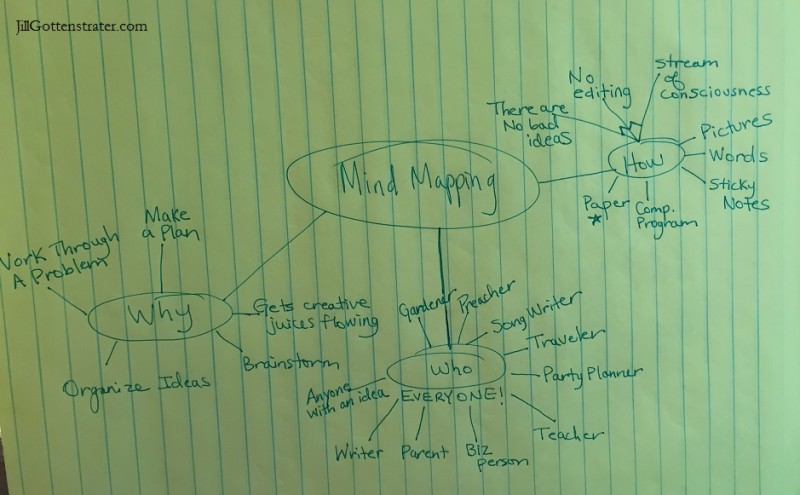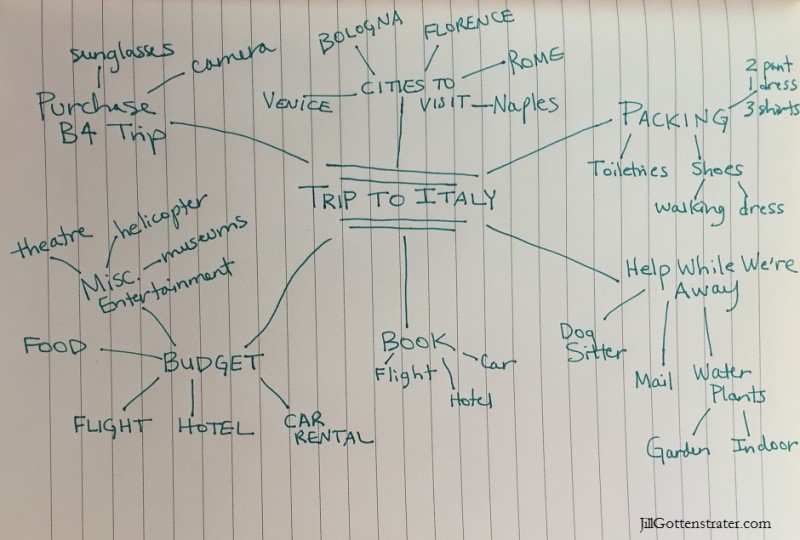Mind Mapping: Who Should Use It and Why
I have an awesome “tool” to tell you about that anyone reading this can benefit from using. This process is fun, will save you time, and will help you retain information.
It’s called mind mapping.
Mind mapping is a process for brainstorming and organizing your ideas.
Wikipedia defines it like this:
A mind map is a diagram used to visually organize information. A mind map is often created around a single concept, drawn as an image in the center of a blank landscape page, to which associated representations of ideas such as images, words and parts of words are added. Major ideas are connected directly to the central concept, and other ideas branch out from those.
I frequently use mind mapping to prepare blog posts. I write the main idea or topic in the center of a page in a notebook and start “throwing” out ideas on the paper all around it. The key is to write without over-thinking—just let the ideas flow. This process will allow you to get all your ideas on the page and then you can go back and edit.
Here is the simple mind map I drew up for this blog post:
WHO CAN BENEFIT FROM MIND MAPPING?
The question should be “who can’t” benefit from mind mapping?
Writers. As I mentioned, I use mind mapping for brainstorming my blog posts. Writers also use this process for organizing and brainstorming ideas for their books. I am going to be writing an e-book in the future and I have already mind mapped all the chapters. I will later mind map ideas around each individual chapter. I’m telling you, this is a fantastic way to organize your thoughts!
Teachers. First of all—God bless and thank you to all you teachers out there! Mind mapping can be an excellent tool for lesson planning. It can also be a tool to teach your students to use for note taking and studying. See next entry…
Students. Mind mapping is a great tool to capture the “main ideas” during lectures or presentations. Students will also find it helpful to use this tool during study and review time; writing out all you know in an organized fashion like this is great for kinesthetic and visual learners.
Parents. The possibilities are endless for this group: meal planning, grocery shopping, choosing schools, back to school shopping, birthday party planning, summer vacation planning, etc.
Vacations Planners. That’s you! Next time you plan a vacation, sit down with a piece of paper, write your destination in the middle and draw spokes out with all your dreams, ideas, and to-dos for your trip. (I’m using Italy as an example in the “how-to” section below.)
Party Planners. Whether it’s a party for a 2 year old or a 50 year old, the process of mind mapping will draw out all kinds of ideas, many which will get nixed, but you may come up with a brilliant idea that you wouldn’t have thought of had you not completed a mind map. Your mind map will also visually organize your grocery, decorations, and party favors list like a charm!
Gardeners. The process of mind mapping can take a huge, overwhelming task and bring it down into manageable “chunks.” Consider mind mapping out your next vegetable or flower garden—I think it would be fun to sketch pictures for this “map.” If you have several areas you are working on, you may create a grand overall mind map and then create mini mind maps for each individual section.
Business People. Whether you’re working up a rough agenda for a meeting, a strategic plan, a proposal, or a presentation, mind mapping works well for lots of business applications. Get a flip chart out at your next planning meeting and mind map out everything discussed with your co-workers. Getting the visual out in front of everyone will generate even more ideas than discussion alone.
Preacher or other Public Speakers. Not only will this help you organize your message or speech, but it will provide a visual that will stick in your mind—a good thing to reference if your nerves get the best of you or you have lost your place.
Song Writers. I’ve never written a song, but I imagine this process could be a fun, creative tool for song writers, just as it would be for a writer. Are you a song writer? I’d love for you to try this process and let me know how it worked out for you.
As you can see, mind mapping can be used by pretty much anyone for anything. Grab a pen and paper and try it out.
HOW TO MIND MAP?
TOOLS:
Paper.
Pencil, pen or markers.
Sticky notes. This is similar to the paper and pencil method, but you are writing out your words/ideas on sticky notes instead. The advantage to this method is you can rearrange/remove/add sticky notes during the editing process.
Computer programs. I prefer pencil and paper, but click here to see who LifeHacker.com chose as their top five mind mapping software programs. I’d personally add Microsoft Word, Excel, PowerPoint, and/or Publisher to the mix—all of which most of us have access to.
PROCESS:
Let’s use an example of planning a vacation for this exercise. I’ve sketched out a simple mind map to go with our example and placed it right below the three steps here.
- Write your main idea in the center of your paper. Trip to Italy.
- Now, think of all the things you will need/want to do in preparation for your trip. Draw lines out from the middle idea to these subsets. For example: Budget, places of interest to visit, packing list, home and pet care while you are away, items to purchase before the trip, transportation and accommodation bookings.
NOTE: It’s important in this step to just get everything out on the paper—don’t overthink and don’t edit during this step. You can fine tune your “map” later. - Voila! It’s that easy. You’re now more organized and much closer to your trip to Italy!
- Now you’ve got a “to do” list all ready for your trip. As you approach your vacation date, you may decide to create mini mind maps for each sub-section to get in greater detail if you’re a nerd like me.
Remember when mind mapping, there are no bad ideas. Get everything out on paper and edit later. Have fun!
Let me know how your mind mapping goes. I’d love to see pictures of you work. You can email your pictures to me here.
Wanna see some really cool, artsy mind maps? Click here.
I appreciate you spending time with me today.
Jill xx




